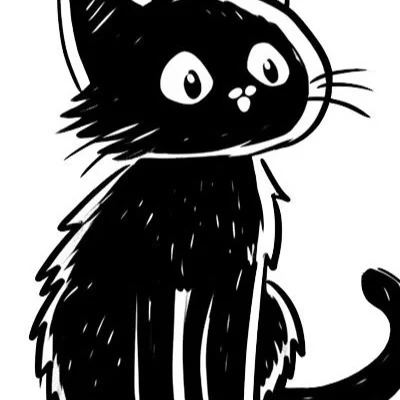How to Draw a Cat in 5 Simple Steps
Learn how to draw a cat with this helpful and detailed step-by-step guide with tips, techniques, and ideas to bring your feline drawings to life.

Materials You'll Need
- Drawing paper
- Pencil (HB or 2B)
- Eraser
- Colored pencils or markers (optional)
- Ruler (for straight lines)
- Compass (for circles)
- Blending stump or tissue (for shading)

Drawing a cat is an enjoyable and rewarding artistic journey that lets you capture the grace, charm, and personality of one of the most beloved animals. Cats, with their sleek bodies, expressive eyes, and soft fur, are an inspiring subject for artists of all skill levels. Whether you're a beginner just getting started or an experienced artist refining your skills, learning how to draw a cat allows you to explore both realism and creativity.
In this tutorial, we'll guide you step by step through the process of drawing a cat, from sketching its basic structure to adding fine details like fur texture and shading. By breaking the process into manageable steps, you'll gain the confidence to create a lifelike representation of a cat that showcases its beauty and personality.
So grab your pencils, paper, and a bit of patience, and let's bring this feline friend to life on paper!



Materials Required
-
Eraser
-
Drawing paper
Step 1: Draw the Basic Shapes
Begin with the Foundation: When sketching, starting with basic shapes helps in establishing proportions.
-
Head: Draw a large circle for the head. This will serve as the base for the facial features.
-
Snout: Sketch a smaller oval or circle at the lower half of the large circle. This will help in defining the cat's muzzle later on.
-
Body: For the body, envision an elongated oval or a kidney bean shape which signifies the cat's torso.
-
Tail: Extend a slightly curved or straight line from the rear end of the body for the tail, depending on the pose or the cat's mood you want to depict.
-
Ears: Add two triangular or small oval shapes on top of the head circle for the ears, keeping them symmetrical and alert.
Step 2: Refine the Shapes
From Basic to Specific:
-
Legs: Starting from the bottom of the torso shape, draw four elongated shapes (like cylinders) representing the legs. Remember, cats have a graceful gait, so aim for slender, tapered legs.
-
Back & Tail: Adjust the initial curved line of the back, adding more contour to represent the cat's spine and muscles. Similarly, give the tail a more three-dimensional appearance by slightly broadening it.
-
Snout: Refine the smaller circle to create the cat's snout. This includes a slight protrusion for where the nose will sit and indentations for the mouth area.
Step 3: Sketch the Details
Giving Character to Your Cat:
-
Eyes: Halfway between the top of the head circle and the snout, sketch two almond-shaped eyes, ensuring they're evenly spaced on either side.
-
Nose & Mouth: Place a small, upside-down triangular shape in the center of the snout for the nose. Draw a gentle 'W' shape below the nose to form the mouth.
-
Fur Direction: As you add details, remember the fur's flow. On the face, it radiates outwards, while on the body, it follows the direction from head to tail.
Step 4: Add Shading and Texture
Bringing the Drawing to Life:
-
Shading Basics: Use the side of your pencil for broader strokes. Shade areas like under the chin, belly, inside of the ears, and where the legs meet the body. These are areas where light naturally casts shadows.
-
Fur Texture: Using short, curved, and overlapping strokes, mimic the texture of fur. Vary your pencil pressure to get a range of light and dark lines.
Step 5: Final Touches
Perfecting Your Artwork:
-
Review: Take a moment to step back and scrutinize your drawing from a distance. This will give you a fresh perspective on any adjustments needed.
-
Whiskers & Details: Don't forget those delicate whiskers! Draw them with light, quick strokes emanating from the snout.
-
Clean Up: Use an eraser to clean up any unnecessary guidelines or stray marks, and if desired, reinforce the outlines of the cat for added emphasis.
Congratulations! You have successfully learned how to draw a cat. With practice, you can refine your skills and draw even more complex and beautiful animals.
Tip: To effectively capture the essence of a cat in your drawing, start with light, loose sketches to outline the basic shapes. Use a 2H pencil for initial lines; this will allow you to easily erase and adjust as you refine your drawing. Focus on the proportions of the head, body, and limbs—cats have unique curves and angles that give them character. Once you're satisfied with the structure, switch to a darker pencil, like a 2B, to add details such as the eyes and fur texture. Remember to observe photographs or even a real cat if possible; studying their anatomy and posture will greatly enhance your portrayal. Keep practicing, and soon you'll be able to capture a cat's personality beautifully!
Gallery of Cat Drawings






Fun Facts About Cats
-
A group of cats is called a clowder or glaring, but if they are kittens, it's called a kindle.
-
Cats are known for their agility and can jump up to six times their body length.
-
The domestic cat is believed to be descended from the African wildcat, Felis silvestris lybica.
-
Cats spend around 70% of their lives sleeping, averaging 13 to 16 hours a day.
-
Each cat's noseprint is unique, much like a human fingerprint.
-
Cats have been associated with humans for thousands of years, with the earliest evidence of cat domestication dating back to around 7500 BC.
-
They have a specialized collarbone that allows them to always land on their feet when they fall.
-
Cats communicate using a range of vocalizations, with more than 100 different sounds.
-
In ancient Egypt, cats were regarded as sacred and were often mummified alongside their owners.
-
The world's oldest known pet cat was found in a 9,500-year-old grave on the Mediterranean island of Cyprus.
Cat Draw Battle
Who drew it better? Cast your vote below!

Oliver Hart
Pencil Picasso


Celeste Marlow
The Shading Sorceress

Be the first to vote in this epic Draw Battle!
Suggestions for Scenes and Settings for Cat Drawings
-
Sunny Windowsill: Draw cats lounging on a sunny windowsill, basking in the warm sunlight streaming through the glass.
-
Garden Adventure: Illustrate a group of curious cats exploring a garden, with colorful flowers and butterflies fluttering nearby.
-
Cozy Living Room: Capture a scene of cats curled up on a couch in a cozy living room, surrounded by soft cushions and blankets.
-
Mystical Forest: Create a scene with cats prowling through a mystical forest, with dappled light and mysterious shadows.
-
Playful Chase: Show cats playfully chasing each other across a flower-strewn meadow, with a blue sky and fluffy clouds overhead.
-
City Rooftop: Depict cats gazing out over a bustling city from a rooftop perch, with twinkling lights and a starry sky.
-
Library Nook: Draw cats nestled among dusty books and shelves, perhaps wearing tiny reading glasses.
-
Moonlit Alley: Illustrate a scene of cats sneaking through a moonlit alley, with the silhouette of the cityscape against the night sky.
-
Harvest Field: Create a drawing of cats frolicking through a ripe harvest field, with tall golden stalks and a gentle breeze.
-
Seaside Harbor: Show cats strolling along a seaside harbor, with boats bobbing in the water and seagulls flying overhead.
These ideas can help you explore different themes and environments to add character and depth to your cat drawings. Enjoy bringing these furry friends to life in your art!